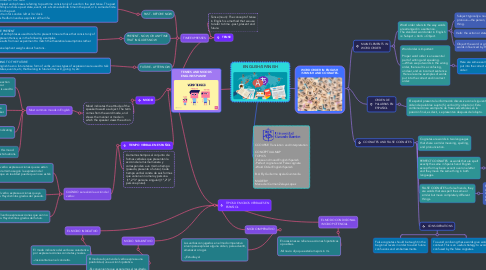
1. TENSES AND MOODS ENGLISH/SPANISH
1.1. TENSE
1.1.1. Tense (noun): The concept of tense in English is a method that we use to refer to time - past, present and future.
1.1.2. TIME EXPRESSES:
1.1.2.1. PAST - BEFORE NOW
1.1.2.1.1. REFERRING TO THE PAST The simplest verb phrases referring to past time consist only of a verb in the past tense. The past tense firmly anchors a past state, event, etc. at some definite time in the past, or in some definite period in the past. (1) The train for London left at 3 o'clock. (2) Miss Redfurn lived as a spinster all her life.
1.1.2.2. PRESENT - NOW, OR ANY TIME THAT INCLUDES NOW
1.1.2.2.1. REFERRING TO THE PRESENT The simplest forms of verb phrases used to refer to present time are those that consist only of a main verb in the present tense, as in the following examples. (1) We expect the results from our experiment to match the theoretical assumptions rather closely. (2) On an average an elephant weighs about five tons.
1.1.2.3. FUTURE - AFTER NOW
1.1.2.3.1. REFERRING TO THE FUTURE Since English has no future tense form of verbs, various types of expressions are used to talk about states, events, etc, that belong to future time: will, going to, etc.
1.2. MOOD
1.2.1. Mood indicates the attitude of the speaker toward a subject. The term comes from the word mode, and shows the manner or mode in which the speaker views the action.
1.2.1.1. Most common moods in English
1.2.1.1.1. THE INDICATIVE MOOD tells us that the action of the verb really happens or is likely occur. Generally this means that the indicative is used to tell facts.
1.2.1.1.2. THE IMPERATIVE MOOD indicates a command that is given by the speaker.
1.2.1.1.3. THE SUBJUNCTIVE MOOD. In English, this mood expresses hypothetical or contrary-to-fact situations.
1.2.1.1.4. THE INTERROGATIVE (indicating a state of questioning):
1.3. TIEMPO VERBAL EN ESPAÑOL
1.3.1. Llamamos tiempos al conjunto de formas verbales que presentan la acción de la misma manera y corresponden a un mismo tiempo (pasado, presente o futuro). Cada tiempo verbal consta de seis formas que varían en número y persona. (1°,2°3° persona singular) (1°,2°,3° persona plural).
1.3.2. CUÁNDO se realizó la acción del verbo:
1.3.2.1. PRESENTE. El verbo expresa acciones que se están realizando ahora mismo según la expresión del hablante (aunque en realidad puede que no se estén dando ahora).
1.3.2.2. PASADO. El verbo expresa acciones que ya han pasado. Hay distintos grados del pasado.
1.3.2.3. FUTURO. El verbo expresa acciones que aún no han pasado. Hay distintos grados del futuro.
1.4. TIPOS DE MODOS VERBALES EN ESPAÑOL
1.4.1. EL MODO INDICATIVO
1.4.1.1. El modo indicativo del verbo se caracteriza por expresar acciones concretas y reales. -José cantará en el concierto.
1.4.2. MODO SUBJUNTIVO
1.4.2.1. El modo subjuntivo del verbo expresa una posibilidad, una acción hipotética. -Es conveniente que esperemos el resultado.
1.4.3. MODO IMPERATIVO
1.4.3.1. Los verbos conjugados en el modo imperativo sirven para expresar alguna orden, para advertir, amenazar o rogar. -¡Estudia ya!
1.4.4. EL MODO CONDICIONAL /MODO POTENCIAL
1.4.4.1. En ocasiones se refiere a acciones hipotéticas o posibles. -Mi novio dijo que estaría mejor sin mi.
2. CCOURSE: Translation and Interpretation CONCEPTUAL MAP TOPICS: -Tense and mood English/Spanish -Perfect cognate and False cognate -Word Order English/Spanish B.A Ely Guillermo Ayala Quintanilla MADE BY: Maria del Carmen Zelaya Lopez
3. WORD ORDER IN ENGLISH /SPANISH AND COGNATES.
3.1. MAIN ELEMENTS IN WORD ORDER:
3.1.1. Word order refers to the way words are arranged in a sentence. The standard word order in English is: Subject + Verb + Object.
3.1.1.1. Subject: typically a noun or pronoun—the person, place or thing.
3.1.1.2. Verb: the action or state of being.
3.1.1.3. Object: the word or group of words influenced by the verb.
3.1.2. Word order is important: Proper word order is an essential part of writing and speaking. —When we put words in the wrong order, the result is a confusing, unclear, and an incorrect sentence. Here are some examples of words put into the correct and incorrect order:
3.1.2.1. Here are some examples of words put into the correct and incorrect order:
3.1.2.1.1. I have 2 brothers and 2 sisters at home. CORRECT
3.1.2.1.2. 2 brothers and 2 sisters have I at home. INCORRECT
3.2. ORDEN DE PALABRAS EN ESPAÑOL
3.2.1. El español presenta la información discursiva con el siguiente orden de palabras: sujeto (S), verbo (V) y objeto (o). Esta combinación se acompaña de frases adverbiales en la posición final, es decir, se presentan después del objeto.
3.2.1.1. 2 TIPOS PRINCIPALES DE ORDEN
3.2.1.1.1. Orden natural Sujeto-Verbo-Objeto-Complementos adverbiales Ejemplo: Los poetas buscan a las musas en el cielo.
3.2.1.1.2. Orden invertido Complementos adverbiales-Sujeto-Verbo-Objeto Ejemplo: En el cielo, los poetas buscan a las musas.
3.3. COGNATES AND FALSE COGNATES
3.3.1. Cognates are words in two languages that share a similar meaning, spelling, and pronunciation.
3.3.2. PERFECT COGNATES as words that are spelt exactly the same in Spanish and English except for maybe an accent over one letter and they mean the same thing in both languages.
3.3.2.1. ENGLISH – SPANISH COGNATES Actor Actor Admirable Admirable Agenda Agenda Alcohol Alcohol
3.3.3. FALSE COGNATES or false friends, they are words that are spelt the same or similar but mean completely different things.
3.3.3.1. ENGLISH – SPANISH FALSE COGNATES Advertisement advertencia Assist asistir Carpet carpeta College colegio
3.3.4. CONSIDERATIONS
3.3.4.1. False cognates should be taught in the beginner levels in order to avoid future confusions and embarrassments.
3.3.4.2. To avoid confusing these words give words within a context. This is an useful strategy to avoid getting confused by the false cognates.
